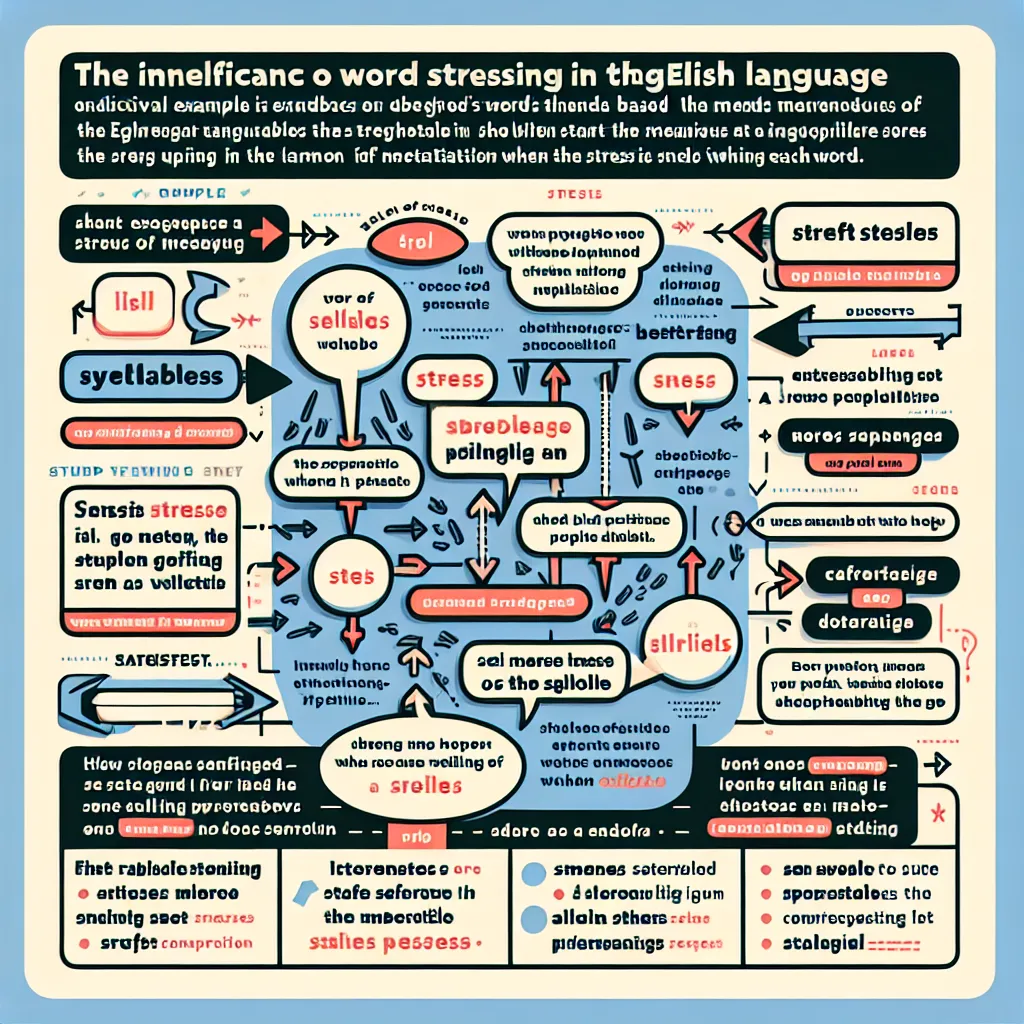Word stress is a crucial aspect of English pronunciation that can significantly impact your ability to communicate effectively. Mastering this skill can enhance your overall fluency and help you sound more natural when speaking English. In this comprehensive guide, we’ll explore various techniques and strategies to help you master English word stress.
Understanding Word Stress in English
Word stress refers to the emphasis placed on specific syllables within words. In English, stress patterns play a vital role in conveying meaning and can even change the function of a word. For example, the word “present” can be both a noun (PREsent) and a verb (preSENT), depending on which syllable is stressed.
Why is Word Stress Important?
Proper word stress is essential for several reasons:
- Clarity: Correct stress patterns make your speech more understandable to native speakers.
- Meaning: As mentioned earlier, stress can change the meaning or function of a word.
- Rhythm: English has a natural rhythm that relies heavily on stressed and unstressed syllables.
- Accent reduction: Mastering word stress can help reduce a foreign accent.
 English Word Stress
English Word Stress
Basic Rules of English Word Stress
While there are exceptions, here are some general rules to help you identify stressed syllables:
- Two-syllable nouns and adjectives: Stress is usually on the first syllable (e.g., TAble, HAppy).
- Two-syllable verbs: Stress is often on the second syllable (e.g., beLIEVE, deCIDE).
- Words ending in -tion, -sion, -cian: Stress is on the syllable before the suffix (e.g., informaTION, televiSION, musiCIAN).
- Words ending in -ic, -ical: Stress is on the syllable before the suffix (e.g., geoGRAphic, hisTORical).
- Compound nouns: Stress is usually on the first word (e.g., BLACKboard, FOOTball).
Techniques for Mastering Word Stress
1. Listen and Imitate
One of the most effective ways to improve your word stress is by listening to native speakers and imitating their pronunciation. Here are some strategies:
- Watch English movies and TV shows with subtitles.
- Listen to podcasts and audiobooks.
- Use pronunciation apps that provide audio examples.
- Practice with English pronunciation podcasts to focus specifically on stress patterns.
2. Use a Dictionary
Modern dictionaries often include stress markers for each word. Familiarize yourself with these symbols and make it a habit to check the stress pattern when learning new words.
3. Practice with Stress Patterns
Create lists of words with similar stress patterns and practice them together. For example:
- Words with stress on the first syllable: PICture, TAble, APple
- Words with stress on the second syllable: beLIEVE, deCIDE, reTURN
4. Exaggerate Stress
When practicing, exaggerate the stress by speaking the stressed syllables louder and longer. This will help you internalize the correct patterns.
5. Use Rhythm and Music
English has a natural rhythm that’s closely tied to word stress. Try these exercises:
- Clap or tap the rhythm of sentences, with stronger claps for stressed syllables.
- Practice with jazz chants or English songs that emphasize natural speech rhythms.
6. Focus on Word Families
Many related words follow similar stress patterns. Learning these patterns can help you predict stress in unfamiliar words. For example:
- PHOtograph, phoTOgraphy, photoGRAphic
- TELegraph, teLEgraphy, teleSCOPE
Common Mistakes and How to Avoid Them
When learning English word stress, learners often encounter several challenges. Here are some common mistakes and tips to overcome them:
-
Stressing every word: In natural English speech, function words (articles, prepositions) are usually unstressed. Focus on stressing content words (nouns, verbs, adjectives, adverbs) instead.
-
Ignoring syllable length: Stressed syllables are not only louder but also longer. Practice elongating stressed syllables slightly.
-
Misplacing stress in compound words: Remember that compound nouns usually stress the first word (e.g., HOT dog), while phrasal verbs stress the second word (e.g., wake UP).
-
Overlooking stress shifts: Some words change stress when adding suffixes. For example: PHOtograph → phoTOgraphy. Be aware of these changes when learning new vocabulary.
-
Neglecting sentence stress: Word stress interacts with sentence stress. Practice emphasizing the most important words in a sentence, which are typically content words.
For more detailed guidance on improving your overall pronunciation, check out our pronunciation tips for non-native speakers.
Phonemic Chart and Commonly Mispronounced Words
Understanding the phonemic chart can greatly aid in mastering word stress. Here’s a simplified version focusing on vowel sounds, which are crucial for stress:
- /iː/ as in “sea”
- /ɪ/ as in “sit”
- /e/ as in “bed”
- /æ/ as in “cat”
- /ʌ/ as in “cup”
- /ɑː/ as in “car”
- /ɒ/ as in “hot”
- /ɔː/ as in “saw”
- /ʊ/ as in “put”
- /uː/ as in “blue”
- /ə/ as in “about” (unstressed)
Here are 10 commonly mispronounced words related to word stress, along with their correct pronunciations:
- comfortable (COM-fuh-tuh-buhl)
- development (di-VEL-uhp-muhnt)
- vegetable (VEJ-tuh-buhl)
- interesting (IN-tuh-res-ting)
- photographer (fuh-TOG-ruh-fer)
- catastrophe (kuh-TAS-truh-fee)
- hierarchy (HAI-uh-rahr-kee)
- pronunciation (pruh-nuhn-see-AY-shuhn)
- miscellaneous (mis-uh-LAY-nee-uhs)
- particularly (puh-TIK-yuh-luh-lee)
Practice these words regularly, paying close attention to the stressed syllables.
 English Phonemic Chart
English Phonemic Chart
Conclusion
Mastering English word stress is a journey that requires patience, practice, and persistence. By incorporating these techniques into your daily language learning routine, you can significantly improve your pronunciation and overall fluency in English. Remember to listen actively, practice regularly, and don’t be afraid to make mistakes – they’re an essential part of the learning process.
For more tips on improving your English pronunciation and intonation, check out our guide on tips for mastering English word stress and intonation. Keep practicing, and soon you’ll notice a marked improvement in your ability to stress words correctly and speak English more naturally.
We’d love to hear about your experiences with mastering English word stress. Share your thoughts, challenges, or success stories in the comments below!




